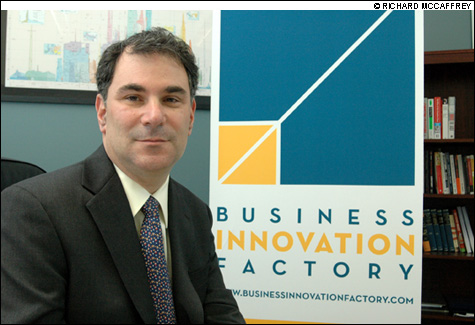Rhode Island is poised for a wireless leap forward with the first-in-the-nation statewide network

SMALL IS BEAUTIFUL: Kaplan, a leader in the state’s effort to cultivate the creative economy, calls technology a way for Rhode Island to “fight above its punch weight.”
|
When Rhode Island boomed, it was because it was ahead of the curve — both with its involvement in the nefarious trans-Atlantic slave trade, and later, when Samuel Slater introduced the water-powered mill in Pawtucket.
In fact, an argument can made that just as the Industrial Revolution was sparked in Rhode Island, so, too, did the withering of the Industrial Age, with the loss of the manufacturing infrastructure that once made Providence the richest city in America, begin here. As it often goes, the first to flourish was the first to decline.
This is a story about people who hope to change all that.
Operating from a refurbished mill west of the Providence Place Mall, once a hot spot of Providence’s industrial economy, a group of innovation leaders plan to make Rhode Island the first state with a fast and accessible border-to-border wireless network that could spur economic growth, improve government services, and enhance the Ocean State’s place in the 21st century.
Before you harbor hopes of being able to surf the Web from the beach or check your e-mail from a public park, it should be noted that this wireless network is not oriented to consumers. It’s primary purpose is to serve businesses and nonprofits, and to spur economic growth by increasing efficiencies and communication in organizations.
The Rhode Island Wireless Innovation Networks (RI-WINs) is a public-private partnership that has worked closely with the state Economic Development Corporation (EDC) to get a wireless network completed by the end of 2008, at a cost of $28 million — none of which will be borne by the public.
Boosters point to myriad possibilities. Imagine, for example, that an EMT is able to provide immediate streaming data to a hospital as a heart attack victim is being taken there, so that doctors have real-time knowledge of the patient’s condition. Think of teachers who are able to build ties between students and parents, thanks to constantly updated and easily viewable student portfolios. Or consider the increased coordination and efficiency with which emergency responders could operate during a hurricane, terrorist attack, or other calamity.
As information and knowledge prove instrumental to a growing economy, a statewide wireless network is pegged as a way to increase organizations’ ability to share information and improve efficiencies. This big vision, the same kind of imagination that helped build the inter-continental railroad and the federal highway system, is now driving an effort to build the nation’s first statewide wireless network.
The man with the plan
Using a boxing metaphor, Saul Kaplan calls technological prowess an important way for Rhode Island “to fight above its punch weight.”
Kaplan, the executive director of the Rhode Island Economic Development Corporation, is perhaps the single-most important person when it comes to advocating for the state’s nascent creative economy. (He also chairs the board of directors of the Slater Technology Fund and the Quonset Development Corporation.)
Kaplan, a 1979 graduate of the University of Rhode Island’s pharmacy program, started his career in Eli Lilly’s pharmaceutical division, where he helped to pilot the introduction of Prozac into the US market. He then joined one of the nation’s top consulting firms, Accenture, as a senior strategy partner focused on the pharmaceutical and the biotech industries. Kaplan worked with large corporations to design and implement global strategies to bring new products to market faster. It was in this work that he learned the importance of making innovation central, not just in the business world, but also in public policy.
In 2004, Kaplan founded the Business Innovation Factory (BIF), an independent, nonprofit organization dedicated to bringing public and private sector partners together to find new ways of delivering important services. The BIF was created as a tool, he says, to implement an economic development model called “Innovation @ Scale.”
The basic idea is that well-conceived partnerships can leverage the Ocean State’s small size and strong social networks to create a lively experiment of fresh ideas and development models. Further, it would be these kinds of innovative partnerships, across industries and sectors, which could build Rhode Island’s information-based economy and provide new business opportunities as well as good-paying jobs. “What we were trying to create was not a tweaking of the old economy, but a repositioning to a 21st century economy,” Kaplan says.
RI-WINs, the creation of a statewide, border-to-border, wireless broadband network, became the first major test of this strategy to bring public and private interests together.
The premise was simple: big and small companies, as well as local and state governments, have an interest in improving efficiencies, customer service, and the transfer of data, while participating in a technological experiment that could put Rhode Island on the map as the first state to establish a statewide wireless network. While 24 other states are pursuing some form of statewide wireless project, Rhode Island’s early vision and partnerships put the state on a path to complete its network first.